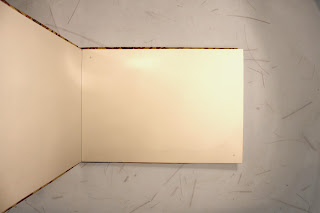As the narrative voice is such an important element to my film it was suggested that I look into the possibility of having it, and the other sound elements, professionally recorded. The intention had always been to employ a professional voice actor if possible for the production. To this end I contacted a personal friend, Charlie O'Neill, who is the creative director at an advertising agency to seek his feedback and advice. Charlie was very generous with his response and recommended the actor Barry Barnes to us who he has worked with on many occasions.
Barry is an experienced stage and screen actor, his credits include the motion pictures Veronica Guerin and KINGS. He is also an experienced voice over artist, recently working on the Irish language recording for Cartoon Saloons The Breadwinner. I sent Barry the animatic for the film along with supporting background material including the script and he very generously agreed to work with us recording the voice-over.
Charlie also recommended a sound engineer and production studios, Tony Kiernan of Moynihan Russell, whom he also works with on an ongoing basis. I contacted Tony, sending him the same material which I had sent to Barry, and again Tony and Moynihan Russell agreed to work with us on the production. Tony proposed that we come in and record the voice over first and then when the animation was near production to come back in to arrange the music and sound effects.
Myself and Sadhbh Lawlor arranged to come in to Moynihan Russell studios on a wintry afternoon in early January to record the voice over. I had a few conversations with Barry beforehand discussing the direction we were interested in taking with the voice over. In conversation with Sadhbh also we outlined some of the reasons we wanted to have a male narrator tell the Melancholic Wife's story. We felt that it is interesting and important to use the power of the male voice to tell this emotionally complex story about a woman's experience. Having an awareness that the male voice is the dominant voice in society at this moment in time and that this type of story deserves to be told by that voice.
This being a new experience for us both we arrived at the sound production studio prepared to fully engage with the process and learn from the expertise of Barry and Tony. From the outset it was a very positive and enjoyable creative experience, both Barry and Tony showed a belief in the project and a willingness to engage in a collaborative space. Tony gave us an overview of the process and what to expect. This helped to manage the nerves both myself and Sadhbh felt at engaging with the process and we were able to get straight into the work of recording.
Before Barry went into the sound booth we went over the creative expectations we had for the voice over. These included exploring a storytelling tone, a familiar tone but with a sense of drama, and following a flow of high and low cadence to mirror the pull and push of the visual struggle which will be depicted. The Barry went in and we held our breath as we heard Sadhbhs written words being spoken in this new way, delivered with a different strength and proficiency by a professional.
From there the collaboration began and what followed was an hour containing ten different recordings exploring ten different ways of expressing the narration with each of us contributing its evolution. Barry would finish a recording and it would spark new ideas and perspectives on the delivery. For one recording Barry proposed telling the story with a detached voice, with no emotional investment in the character, and delivered a narration which highlighted the achievement of the Melancholic Wife within the story. Tony suggested a version where Barry was telling the story down the pub and another pushing the storyteller, Sean-nos aspect to the limit. Sadhbh expressed the ask on the narrator to honour the Melancholic Wife's journey, noting the authoritarian quality that has been prescribed to the narrative voice-over and how to use that consciously.
The discussion around the recordings naturally moved from the technical to the thematic, from the requirements in terms of time to exploring the underlying emotional narrative and creating a character in the narrator. We came away with nine distinct recordings and the good/difficult task of how to decide between them.











































